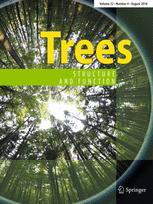View Item
- xmlui.general.dspace_homeCentros e Institutos de InvestigaciónCIRN. Centro de Investigaciones de Recursos NaturalesInstituto de Recursos BiológicosArtículos científicosxmlui.ArtifactBrowser.ItemViewer.trail
- DSpace Home
- Centros e Institutos de Investigación
- CIRN. Centro de Investigaciones de Recursos Naturales
- Instituto de Recursos Biológicos
- Artículos científicos
- View Item
Genetic variability of Araucaria angustifolia in the Argentinean Parana Forest and implications for management and conservation
Abstract
The main forces shaping genetic variability of woody species in fragmented forest are the geographical distribution and demographic history of populations. We conducted molecular analyses to evaluate how these factors have affected Araucaria angustifolia genetic variability in the Argentinean Parana Forest and to identify valuable gene pools for conservation and management purposes. Using 706 polymorphic AFLP (Amplified Fragment Length Polymorphism)
[ver mas...]
The main forces shaping genetic variability of woody species in fragmented forest are the geographical distribution and demographic history of populations. We conducted molecular analyses to evaluate how these factors have affected Araucaria angustifolia genetic variability in the Argentinean Parana Forest and to identify valuable gene pools for conservation and management purposes. Using 706 polymorphic AFLP (Amplified Fragment Length Polymorphism) markers, we analyzed nine native populations with different logging history and one plantation (312 individuals) of an uncertain origin. Average genetic diversity for the native populations was moderate-to-low (He = 0.128) in accordance with their marginal location within Araucaria’s range. In general, genetic diversity of populations decreases from east to west with increasing distances from the main area of species distribution on southern Brazil. Logging may have been responsible for further reduction of genetic variability in the more intensely exploited populations of the southern region and in some private fields. The moderate genetic differentiation among populations (ΦPT = 0.080) suggests an increase in the genetic structure of remnant populations because of fragmentation. UPGMA and Bayesian analyses agreed with the geographic location of populations. Populations from the southern Provincial Parks at Araucaria’s range edges grouped and differed genetically more from other populations. The highest genetic diversity of the plantation (He = 0.155) suggests that its individuals could have originated from seeds collected from different and/or highly variable sources of Brazil and the northeast of Argentina.
[Cerrar]

Fuente
Trees : Structure and Function 32 (4) : 1135–1146 (August 2018)
Date
2018-08
ISSN
0931-1890
1432-2285
1432-2285
Formato
pdf
Tipo de documento
artículo
Palabras Claves
Derechos de acceso
Restringido
 Excepto donde se diga explicitamente, este item se publica bajo la siguiente descripción: Creative Commons Attribution-NonCommercial-ShareAlike 2.5 Unported (CC BY-NC-SA 2.5)
Excepto donde se diga explicitamente, este item se publica bajo la siguiente descripción: Creative Commons Attribution-NonCommercial-ShareAlike 2.5 Unported (CC BY-NC-SA 2.5)

